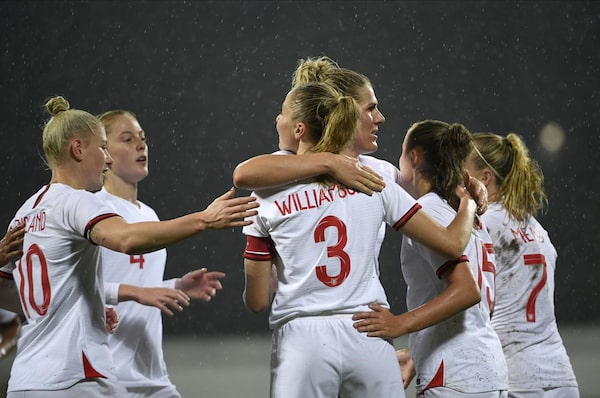
England’s women national team players celebrate after the 2023 Women's World Cup Qualifying match against Latvia at the Daugava stadium in Riga, Latvia, on Oct. 26, 2021.Roman Koksarov/The Associated Press
England has scored 32 goals without reply. France has netted 29 times and conceded twice. Denmark has 28 goals scored and only one allowed.
The opening four rounds of Women’s World Cup qualifying in Europe have shown Nadine Kessler, UEFA’s head of women’s football, why a format change is needed to cut down on one-sided results that have accentuated the gulf in financial resources and number of professional players on different teams.
“The qualification systems for the World Cup and Euro, which UEFA organizes and not FIFA, they’re already going to be examined very closely and we will see an improvement in the future,” Kessler said in an interview with The Associated Press.
While the quartet of heavy wins for England, France and Denmark could partly be attributed by them being in six-team groups – which usually contain at least one low-ranked opponent – Spain in a five-team group has scored 23 goals without its defence being breached in its opening three wins.
UEFA is navigating a balancing act – just like in the men’s game – for how to give lower-ranked nations the experience of competing against elite sides while not stilting their progress by being subjected to heavy defeats.
“I think we need to really take a look closely to have more evenly-matched matches,” Kessler said, “but also to have some opportunities to still see where’s the bar and to compete against the very best.”
UEFA adopted the format used in men’s tournament qualifying for the 2022 Women’s European Championship and 2023 World Cup, splitting the 51 European nations into nine groups – removing forms of pre-qualifying or separation of the higher-ranked teams as had been used previously in the women’s game.
“We’ve done this (preliminary round) already and also maybe that was not the right solution for competitive balance,” Kessler said. “Then it was changed to group stage with all this. I can tell you that the debate about this pre-qualifying seeding, it all happened.”
Kessler was speaking after the draw for Euro 2022, which England qualified for as host nation. So England has only just started to play its first competitive games since reaching the semi-finals of the 2019 World Cup but has faced no demanding opposition.
Starting on the path to the 2023 tournament, which is being co-hosted by Australia and New Zealand, Sarina Wiegman’s side has won 10-0 away at both Luxembourg and Latvia and breezed past Northern Ireland 4-0 at Wembley Stadium last weekend.
“What you want to do is develop women’s football worldwide of course but the difference between qualities now is actually huge and it’s not very competitive when you win 8-0,” Wiegman said after England thrashed North Macedonia to open World Cup qualifying. “Having too many matches which finish 8-0 – or those kinds of results – that’s not good for the game.”
Especially not when trying to attract fans to matches. England’s most testing qualifiers are likely to be against Austria, which has scored 21 goals and let in three in four games but was held to a draw by Northern Ireland.
“We want to take a look properly and not just come up with a quick solution because that qualifying campaign is still important,” Kessler said. “It doesn’t mean that we need to have the exact same format as we now see in the men’s.”
Kessler said one possibility is adopting the Nations League competition that was introduced into the European men’s game in 2018 to produce more competitive fixtures between teams on a similar level by splitting them into brackets.
“We really need to assess properly the actual issues we have and then come up with hopefully a format that will be debated at all and then help European women’s football to grow further,” Kessler said. “There are nuances you have to look at.”
Kessler knows about the challenge in narrowing the gulf well from her playing days. The path to winning the European Championship in 2013 began with Germany scoring 64 goals and conceding only three times while winning nine of its 10 qualifiers and only dropping points once in a draw to Spain.
Kessler – the 2014 world player of the year – has spent recent weeks as part of UEFA’s opposition to FIFA’s push for biennial World Cups. The focus now is selling out games when the pandemic-delayed Euro 2022 is staged next July across England.
“We have got to be realistic and look back on a few previous women’s Euros – we never sold out the tournament,” Kessler said. “European teams dominate on a club level, European teams are at the forefront of investment happening in all the stages. So we want to underline with that tournament again that women’s football is a top priority for Europe.”